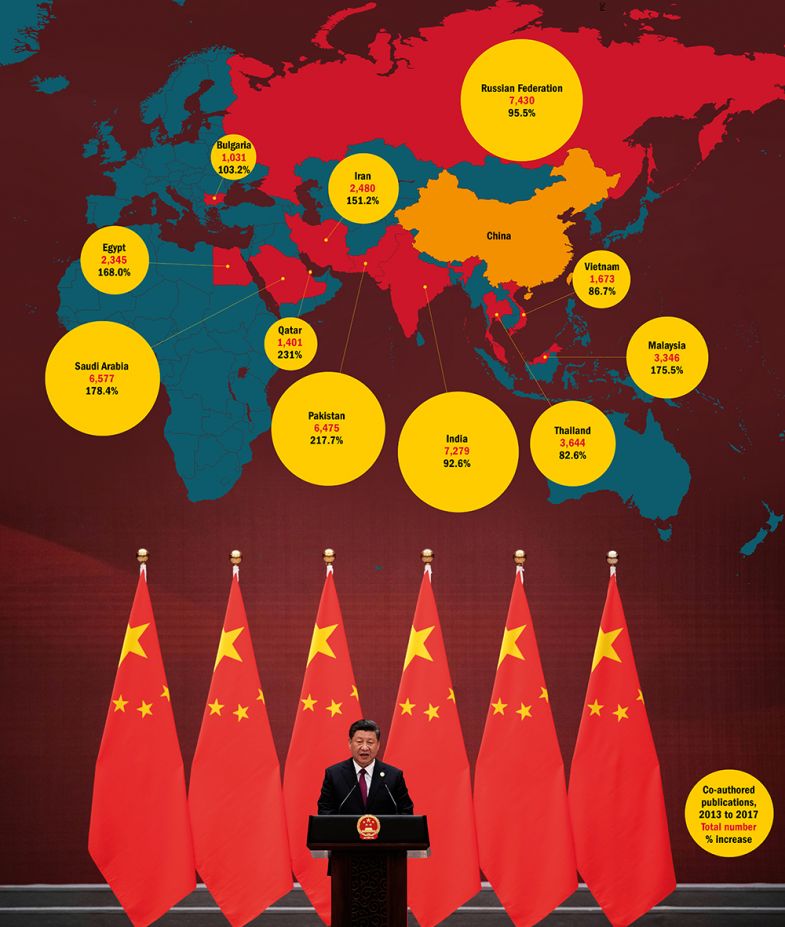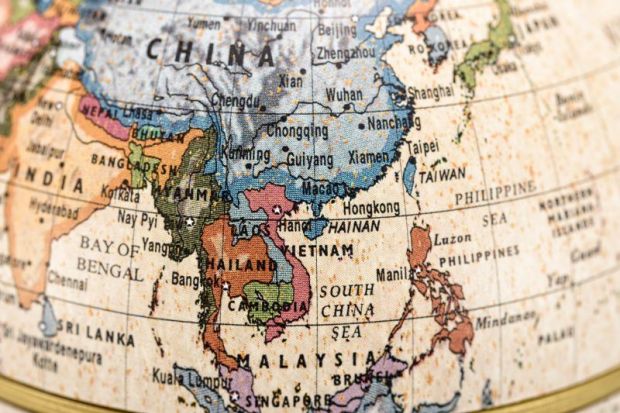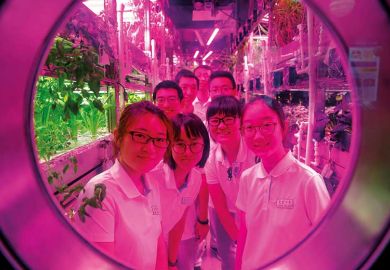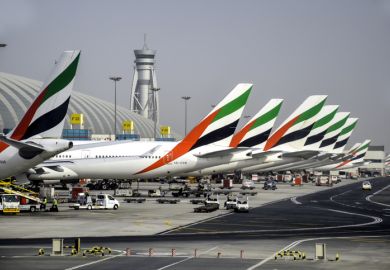China’s Belt and Road project, which is aimed at strengthening its ties with the rest of Asia and beyond, may be primarily about transport and infrastructure.
Since its launch in 2013, the £750 billion project – sometimes described as the 21st-century Silk Road in a nod to the ancient trading route between East and West – has poured money into schemes that aim to improve links between China, Europe, the Middle East and Africa by road, rail and sea.
But it arguably is also the catalyst for a ramping-up of higher education links between China, its nearest neighbours and nations even further afield.
According to data on the amount of academic publications indexed in Elsevier’s Scopus database that feature co-authors from different countries, some of the biggest growth in collaborative research involving China is in other parts of Asia, eastern Europe and north Africa.
For instance, leaving aside countries with the smallest co-authored research output with China (those with fewer than 1,000 co-authored papers between 2013 and 2017), nine nations increased their collaborative research with China by more than 100 per cent in the period 2013-17. All but one (Chile) were along the Belt and Road route.
And just behind them are two of the biggest countries within the Belt and Road sphere of influence – India and Russia – whose research collaborations with China ballooned by more than 90 per cent.
Growth in Chinese collaborations on Belt and Road route

So does this apparent expansion of research links have its roots in the Belt and Road strategy, or does it simply reflect the kind of organic growth that might be expected of developing countries in geographic proximity?
Mike Gow, lecturer in international business at Coventry University’s School of Strategy and Leadership, said it was likely that Belt and Road was playing a part.
“The Belt and Road Initiative is largely known for infrastructure projects, but the promotion of HE collaborations and research that informs [the scheme] is certainly a feature of initiatives and activities across Chinese HE,” he said.
Dr Gow said that the Chinese government might not dictate exactly how universities should build Belt and Road academic links, but it would expect institutions to detail in their five-year plans how their internationalisation projects fed into the initiative’s overarching strategy.
As a result, universities keen to contribute to the strategy might make money available for scholars who collaborate along the Belt and Road route, even if there is no major central fund for academics tied to the initiative.
“They have given universities some kind of headspace to try to think about how they might want to engage with [Belt and Road],” said Susan Robertson, professor of the sociology of education at the University of Cambridge. “There have been funds made available for them to develop their own transnational strategies.”
On the academic side of Belt and Road, she noted, much of the focus – although not all – had been around arts, social science and humanities subjects because of an “absolute awareness” in China that the country needed to bolster creative subjects. There was also a sense that China wanted to “present to the world” the positive contribution it could make to such fields, Professor Robertson added.
Dr Gow said that there were specific schemes aimed at building Belt and Road higher education links, although these were often simply programmes to facilitate academic networks rather than major funding schemes in their own right.
One of the most prominent is the University Alliance of the Silk Road (UASR), established in 2015 and now claiming to involve 150 universities across 38 countries, mainly those along the immediate Belt and Road route but also institutions from as far away as the US.
The only UK institution that is part of the alliance, and a member of its executive council, is the University of Liverpool. Its involvement grew out of its partnership with Xi’an Jiaotong University (the two institutions have a joint campus in Suzhou near Shanghai). Xi’an Jiaotong was central to setting up the UASR because it is located in the central Chinese city of Xi’an, the historic starting point of the ancient Silk Road.
Dinah Birch, pro vice-chancellor for cultural engagement at Liverpool, said that although the UASR was not a scheme on a “huge scale”, it had opened doors to academics working in similar fields in different nations. Liverpool had been closely involved in fostering links between scholars working in cultural heritage fields, for instance, and it hosted a round-table event last year on the topic.
The result, she said, was that the “intellectual and physical traffic” along the Belt and Road route had been increased, something especially true for countries that were previously quite isolated, such as Kazakhstan.
“We are not talking about something that has been transformative, but it has been a valuable channel for conversation, particularly perhaps with central Asian countries,” she said.
There has also been a benefit for students, Professor Birch said, who had the chance to attend summer schools in China set up as part of the UASR initiative and wider opportunities to learn more about Chinese culture, language and higher education.
Student mobility more generally is another aspect of the wider higher education strategy for Belt and Road, with China seemingly on course to hit an ambitious goal of hosting half a million international students by 2020.
Countries along the Belt and Road route seem to be enjoying a new surge of interest from international students, too, data from Times Higher Education’s World University Rankings indicate.
But even if the Belt and Road strategy is driving much of this increasing academic and student mobility – as well as facilitating the flow of ideas – are there political barriers that will limit its expansion, not least lingering suspicions that the Belt and Road Initiative is simply a foreign policy tool to expand China’s global influence?
Dr Gow said although the wider Belt and Road project might have clear soft power goals for China, as long as the initiative remained a priority for Beijing then it was likely to generate cross-border research activity through the way it encouraged Chinese institutions and academics to compete for resources.
“Most research collaboration between [China] and other countries is a scholar-to-scholar arrangement, focused on producing outputs valuable to the scholars themselves,” he pointed out.
Professor Robertson said the fact that this academic dialogue had been opened up along the Belt and Road could help to act as an antidote to any mistrust between West and East. “There has to be a degree of openness; that is an integral part of higher education,” she said.
It is one reason why, according to Professor Birch, it would be a shame if schemes such as the UASR “withered” away at some point if global political developments went in a different direction.
“I do believe that in these tense…times there is benefit in the academics working at the coalface continuing to talk to each other. I think that is what we need. I would feel anxious about a growing academic culture where everyone is closing the door and locking it,” she said.
Find out more about THE DataPoints
THE DataPoints is designed with the forward-looking and growth-minded institution in view
POSTSCRIPT:
Print headline: Is Belt and Road driving closer ties between academics?
Register to continue
Why register?
- Registration is free and only takes a moment
- Once registered, you can read 3 articles a month
- Sign up for our newsletter
Subscribe
Or subscribe for unlimited access to:
- Unlimited access to news, views, insights & reviews
- Digital editions
- Digital access to THE’s university and college rankings analysis
Already registered or a current subscriber? Login








